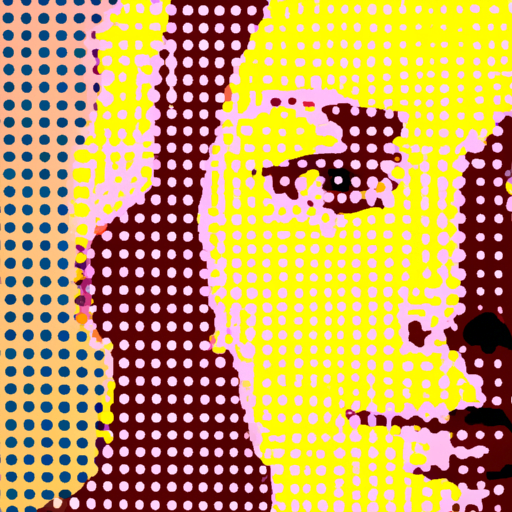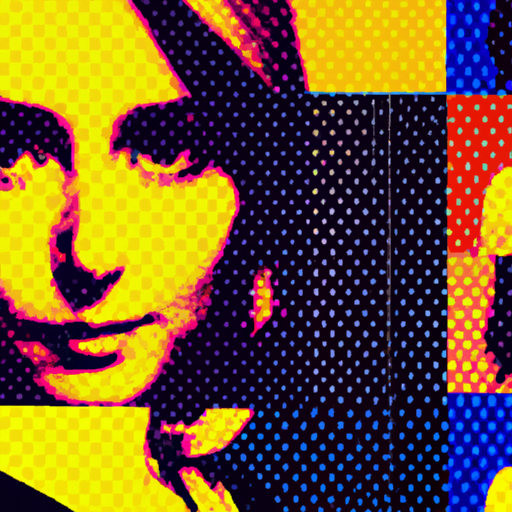
-
Table of Contents
The Use of Halftone Effects in Contemporary Artworks

Contemporary art is constantly evolving, with artists exploring new techniques and mediums to express their creativity. One such technique that has gained popularity in recent years is the use of halftone effects. Halftone effects involve the use of dots or patterns to create shading and texture in an artwork. This article will explore the history of halftone effects, their application in contemporary artworks, and the impact they have on the viewer.
The History of Halftone Effects
The concept of halftone effects can be traced back to the late 19th century when newspapers and magazines started using halftone printing to reproduce photographs. Before the invention of halftone printing, images were reproduced using techniques like engraving or lithography, which were time-consuming and expensive. Halftone printing revolutionized the printing industry by allowing photographs to be reproduced quickly and at a lower cost.
The halftone process involves breaking down an image into a series of dots of varying sizes and densities. The size and density of the dots determine the level of shading and detail in the final printed image. This technique mimics the way our eyes perceive continuous tones and creates the illusion of depth and texture.
Application in Contemporary Artworks
Contemporary artists have embraced halftone effects as a way to add visual interest and depth to their artworks. By incorporating halftone patterns, artists can create unique textures and shading that cannot be achieved through traditional painting techniques alone.
One artist who has successfully incorporated halftone effects into his work is Shepard Fairey. Fairey is known for his iconic “Hope” poster, which features a halftone portrait of Barack Obama. The use of halftone patterns in this artwork adds a sense of depth and dimension to the image, making it visually striking and memorable.
Another artist who has experimented with halftone effects is Yayoi Kusama. Kusama’s “Infinity Mirror Rooms” installations often feature polka dot patterns, which can be considered a form of halftone effect. The repetition of dots creates a sense of movement and infinity, immersing the viewer in a mesmerizing visual experience.
The Impact on the Viewer
The use of halftone effects in contemporary artworks has a profound impact on the viewer. The patterns and textures created by halftone effects can evoke different emotions and interpretations, depending on the context of the artwork.
For example, the use of halftone effects in a portrait can add a sense of nostalgia or vintage aesthetic. The dots create a grainy texture reminiscent of old photographs, transporting the viewer to a different era. On the other hand, halftone effects used in abstract or geometric artworks can create a sense of movement and energy, captivating the viewer’s attention.
Furthermore, the use of halftone effects can also influence the way the viewer perceives the subject matter of the artwork. By manipulating the size and density of the dots, artists can emphasize certain areas or create focal points within the composition. This technique directs the viewer’s gaze and guides their interpretation of the artwork.
Case Studies
To further illustrate the impact of halftone effects in contemporary artworks, let’s examine two case studies:
Case Study 1: Roy Lichtenstein
Roy Lichtenstein was a prominent figure in the Pop Art movement and is known for his comic book-inspired artworks. Lichtenstein often used halftone effects to recreate the look and feel of printed comic book panels. By incorporating halftone patterns, Lichtenstein’s artworks not only pay homage to popular culture but also challenge the distinction between high and low art.
Case Study 2: Damien Hirst
Damien Hirst, a controversial British artist, has also utilized halftone effects in his artworks. In his “Spot Paintings” series, Hirst creates large-scale paintings consisting of numerous colored dots arranged in a grid-like pattern. The halftone effect created by the dots adds depth and texture to the paintings, while the repetition of the dots creates a sense of order and uniformity.
Conclusion
The use of halftone effects in contemporary artworks has become a powerful tool for artists to express their creativity and engage viewers. By incorporating halftone patterns, artists can add depth, texture, and visual interest to their artworks. The impact of halftone effects on the viewer is significant, evoking emotions, directing interpretation, and creating a unique visual experience.
As contemporary art continues to evolve, it is likely that artists will continue to explore and push the boundaries of halftone effects, creating new and innovative ways to captivate and engage their audience.
